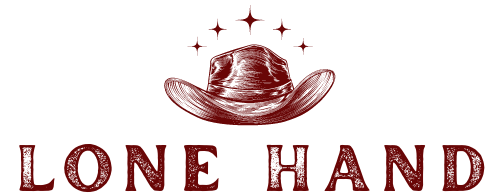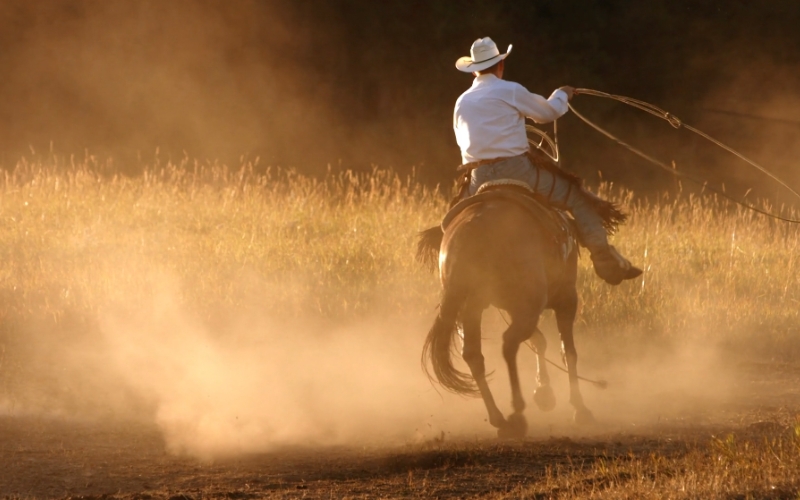There is probably no working attire that is as specific as that of the cowboy. Each article of clothing serves a purpose. Following is an excerpt from the book “The Passing of the Frontier” by Emerson Hough that gives a very accurate description of 1800’s cowboy clothing and gear.
But before you dive into the history of their clothes and gear, go to lonehand.com to learn everything you can about cowboys, their culture, outfits, weapons and much more!
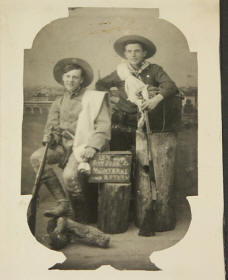
By the costume we may often know the man. The cowboy’s costume was harmonious with its surroundings. It was planned upon lines of such stern utility as to leave no possible thing which we may call dispensable. The typical cowboy costume could hardly be said to contain a coat and waistcoat.
The heavy woolen shirt, loose and open at the neck, was the common wear at all seasons of the year excepting winter, and one has often seen cowboys in the winter-time engaged in work about the yard or corral of the ranch wearing no other cover for the upper part of the body but one or more of these heavy shirts. If the cowboy wore a coat he would wear it open and loose as much as possible.
If he wore a “vest” he would wear it slouchily, hanging open or partly unbuttoned most of the time. There was a reason for this slouchy habit. The cowboy would say that the vest closely buttoned about the body would cause perspiration so that the wearer would quickly chill upon ceasing exercise. If the wind were blowing keenly when the cowboy dismounted to sit upon the ground for dinner, he would button up his waistcoat and be warm. If it were very cold he would button up his coat also.
The cowboy’s boots were of fine leather and fitted tightly, with light narrow soles, extremely small and high heels. Surely a more irrational foot-covering never was invented; yet these tight, peaked cowboy boots had a great significance and may indeed be called the insignia of a calling. There was no prouder soul on earth than the cowboy.
He was proud of being a horseman and had contempt for all human beings who walked. On foot in his tight-toed boots he was lost; but he wished it to be understood that he never was on foot. If we rode beside him and watched his seat in the big cow saddle we found that his high and narrow heels prevented the slipping forward of the foot in the stirrup, into which he jammed his feet nearly full length.
If there was a fall, the cowboy’s foot never hung in the stirrup. In the corral roping, afoot, his heels anchored him. So he found his little boots not so unserviceable and retained them as a matter of pride. Boots made for the cowboy trade sometimes had fancy tops of bright-colored leather. The Lone Star of Texas was not infrequent in their ornamentation.
The curious pride of the horseman extended also to his gloves. The cowboy was very careful in the selection of his gloves. They were made of the finest buckskin, which could not be injured by wetting. Generally they were tanned white and cut with a deep cuff or gauntlet from which hung a little fringe to flutter in the wind when he rode at full speed on horseback.
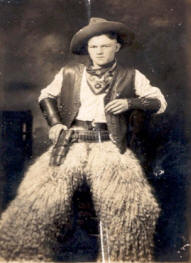
The cowboy’s hat was one of the typical and striking features of his costumes. It was a heavy, wide, white felt hat with a heavy leather band buckled about it. There has been no other head covering devised so suitable as the Stetson for the uses of the Plains, although high and heavy black hats have in part supplanted it today among stockmen. The boardlike felt was practically indestructible.
The brim flapped a little and, in time, was turned up and perhaps held fast to the crown by a thong. The wearer might sometimes stiffen the brim by passing a thong through a series of holes pierced through the outer edge. He could depend upon his hat in all weathers. In the rain it was an umbrella; in the sun a shield; in the winter he could tie it down about his ears with his handkerchief.
Loosely thrown about the cowboy’s shirt collar was a silk kerchief. It was tied in a hard knot in front, and though it could scarcely be said to be devoted to the uses of a neck scarf, yet it was a great comfort to the back of the neck when one was riding in a hot wind. It was sure to be of some bright color, usually red. Modern would-be cowpunchers do not willingly let this old kerchief die, and right often they over-play it. For the cowboy of the “movies,” however, let us register an unqualified contempt. The real range would never have been safe for him.
A peculiar and distinctive feature of the cowboy’s costume was his “chaps” (chaparejos). The chaps were two very wide and full-length trouser-legs made of heavy calfskin and connected by a narrow belt or strap. They were cut away entirely at front and back so that they covered only the thigh and lower legs and did not heat the body as a complete leather garment would.
They were intended solely as a protection against branches, thorns, briers, and the like, but they were prized in cold or wet weather. Sometimes there was seen, more often on the southern range, a cowboy wearing chaps made of skins tanned with the hair on; for the cowboy of the Southwest early learned that goatskin left with the hair on would turn the cactus thorns better than any other material. Later, the chaps became a sort of affectation on the part of new men on the range; but the old-time cowboy wore them for use, not as a uniform. In hot weather he laid them off.
In the times when some men needed guns and all men carried them, no pistol of less than 44-caliber was tolerated on the range, the solid framed 45-caliber being the one almost universally used. The barrel was eight inches long, and it shot a rifle cartridge of forty grains of powder and a blunt-ended bullet that made a terrible missile.
This weapon depended from a belt worn loose resting upon the left hip and hanging low down on the right hip so that none of the weight came upon the abdomen. This was typical, for the cowboy was neither fancy gunman nor army officer. The latter carries the revolver on the left, the butt pointing forward.
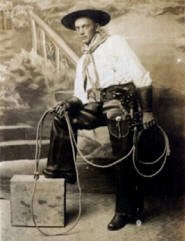
An essential part of the cow-puncher’s outfit was his “rope.” This was carried in a close coil at the side of the saddle-horn, fastened by one of the many thongs scattered over the saddle. In the Spanish country it was called reata and even today is sometimes seen in the Southwest made of rawhide. In the South it was called a lariat.
The modern rope is a well-made three-quarter-inch hemp rope about thirty feet in length, with a leather or rawhide eye. The cowboy’s quirt was a short heavy whip, the stock being of wood or iron covered with braided leather and carrying a lash made of two or three heavy loose thongs.
The spur in the old days had a very large rowel with blunt teeth an inch long. It was often ornamented with little bells or oblongs of metal, the tinkling of which appealed to the childlike nature of the Plains rider. Their use was to lock the rowel.
His bridle—for, since the cowboy and his mount are inseparable, we may as well speak of his horse’s dress also—was noticeable for its tremendously heavy and cruel curbed bit, known as the “Spanish bit.” But in the ordinary riding and even in the exciting work of the old round-up and in “cutting out,” the cowboy used the bit very little, nor exerted any pressure on the reins.
He laid the reins against the neck of the pony opposite to the direction in which he wished it to go, merely turning his hand in the direction and inclining his body in the same way. He rode with the pressure of the knee and the inclination of the body and the light side-shifting of both reins. The saddle was the most important part of the outfit.
It was a curious thing, this saddle developed by the cattle trade, and the world has no other like it. Its great weight—from thirty to forty pounds—was readily excusable when one remembers that it was not only seat but workbench for the cowman. A light saddle would be torn to pieces at the first rush of a maddened steer, but the sturdy frame of a cow-saddle would throw the heaviest bull on the range.
The high cantle would give a firmness to the cowboy’s seat when he snubbed a steer with a sternness sufficient to send it rolling heels over head. The high pommel, or “horn,” steel-forged and covered with cross braids of leather, served as anchor post for this same steer, a turn of the rope about it accomplishing that purpose at once.
The saddle-tree forked low down over the pony’s back so that the saddle sat firmly and could not readily be pulled off. The great broad cinches bound the saddle fast till horse and saddle were practically one fabric. The strong wooden house of the old heavy stirrup protected the foot from being crushed by the impact of the herd. The form of the cow-saddle has changed but little, although today one sees a shorter seat and smaller horn, a “swell front” or roll, and a stirrup of open “ox-bow” pattern.”
Cowboy Boots
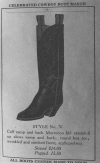
The boot represents one of the most distinguishing articles of cowboy clothing. Distinctive in its style, it stands out as one of the items required to fill out a cowboys uniform. As with the cowboy hat, the boot can trace its origins to the horsemen of the Mongolian steppes in Asia. Like many other pieces of cowboy gear the boot was adapted over time to fit the needs of the working cowhand.
The boots of the early cowhands were generally rather low in the heel and had high uppers that reached almost to the knee. A pair of mule ear flaps at the top of some boots helped facilitate pulling them on. As there was no “right and left” during this time period this could prove to be a chore.
Many cowboys were wearing custom made boots by the 1870’s. The Hyer boot was one of the most popular with the old time cow hands. Early Hyer catalogs advertised a boot with “Calf vamp and back Morocco kid extended up above the vamp; Round box toe; wrinkled and stitched front; scalloped top” for the price of $14.00. This seems to be a pretty hefty sum for the day but we are all slaves to fashion.
The stovepipe boot began to make an appearance around the mid 1870’s.
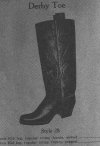
Stovepipe boots utilized stitching in the uppers to help strengthen the tops. Other makers added leather cutouts of various colors to accomplish the same purpose. If you look hard at old photographs you can see hints of half moons and stars on some boots. Some modern boot makers now make replicas of these old stovepipe boots and they are quite attractive.
While many cowboys had their custom made boots most purchased what fit them the best from a local dry goods store. The boots came in big wooden boxes with an assortment of different sizes. The granger boot was ever popular and was made of bull leather. They cost a whopping $2.00 – $4.00.
Montgomery Ward advertised United States government sewn boots in its early catalogs at a price of $2.75. They were described as having a “broad sole, low heel; a comfortable and economical stogy boot.” The low heel worked well with the wider wooden stirrups of the day. As stirrups narrowed in later years a higher heel was need to keep the boot from slipping through the stirrup.
John K. Rollinson stated in his book “Pony Trails In Wyoming”
“All the men were well shod in good looking, riding boots, except the cook. I learned that the boots were mostly made by a boot maker named Hyer, of Olathe, Kansas, and were generally black in color. All had seventeen inch tops, with a two or two and a half inch heel, slanted well forward, so that the weight of the foot came forward of the heel, and consequently the stirrup was held under the arch of the rider’s instep, as it should be.”
These were apparently some tight fitting boots. Rollinson went on to discuss their removal.
“The men were tired, and a bunch of them had removed their boots to ease their feet. I was surprised to see one man back up to another on the ground who wanted to remove his boots which were evidently too tight. His helper took the boot between his legs with one hand on the toe and one on the heel. The wearer of the boots put his free foot against the rump of his helper, and with much wiggling and twisting the boot came off.” In some cases this may seem to be an ageless exercise.
Cowboy Hats
More than anything else the hat sets apart the cowboy from all others. With its high crown and wide brim nothing else in the way of head gear even comes close.
There is some conjecture that the cowboy hat descended from the large hats worn by the Mongol horsemen ages ago. Mexican sombreros are similar to good old Ghengis’ favorite head gear, and the modern cowboy hat evolved from the sombrero.
The hat and many other components of the cowboys working gear can be traced back to equipment brought over by the Spanish. In fact even our long horn cattle were introduced to this country by Christopher Columbus during his second trip to the Americas.

The style of hats varied throughout cattle country due more to the changes in climate than to any concern over a sense of fashion. Typically the farther south a person went into cattle country the larger the brim of the hat.
With the abundance of hot, sunny days in the southwest the sombrero and other hats with large brims provided cooling shade during long hours on horse back. The old style southern planters hats also were also utilized by the southwestern cowboy.
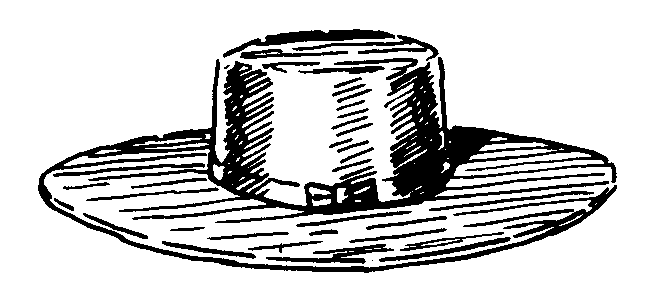
Believe it or not one of the first sources for cowboy hats was the Montgomery Ward catalog. In the early 1870s Monkey Wards was offering a “Men’s Panama Hat” and around 1878 the “Planters Hat” was introduced.
The hat was manufactured in drab colors and made either of Saxony wool felt or Cassimere fur felt. This limited offering indicates that they were probably not to popular an accoutrement during the 1870s and the cowboys made do with what they had.
The extreme variations in temperature and high winds of the northern plains called for a hat different in design from its southern cousins. Made of heavy felt, the northern cowboys hat provided insulation from both the heat and the cold experienced on the range. Over time a cowboys beloved hat would take on a character of its own due to constant abuse and scrunching.
Take time to look at some old pictures and you will see that every one in the picture has a hat distinctive to itself. It is no wonder they were a prized possession and continues to be so to this day.
John B. Stetson was the father of the western style cowboy hat. He began production of the “Boss of the Plains” hat in 1865.
The hat had a four inch brim and crown and sold for around $5.00. It weighed a grand total of 2ounces and you could choose between the colors of natural or natural. The hat grew in success and became the most popular on the plains. The “Boss of the Plains” came unformed and the cowboy could shape the hat to his individual taste. Judging by old pictures some attempts at hat shaping were not too successful. Regardless of how ridiculous the hat looked those old cowhands looked proud.
Design of crown creases and brim shapes tended to vary from region to region. Often you could tell where a cowhand worked by the type and design of his hat. In later years it became evident to the Stetson company that shaped hats were the way to go and they provided a line of pre shaped hats. The old west cowboy could now choose from a variety of styles with names like: Bronco, Dakota, Austin, Roundup, Big Four, Carp, Carlsbad, Calgary, etc.
Prices of hats varied according to quality starting at around $14.00 for a number one quality to $35.00 or more for 7X beaver. Based on the $30.00-$40.00 per month salary of the average cowhand a new hat was no small investment.
Not to be left out, both Sears Roebuck Company and Montgomery Wards offered their own line of hats and continued to do so into the early 1900s. Sears used carry the “Chief Moses” an ungainly thing that came with an option of vibrant red stars. A cowboy could supposedly arrange the stars however he saw fit and come up with some sort of masterpiece. There had to have been a few fireside ribbing sessions delivered to the proud owners of “Chief Moses” hats.
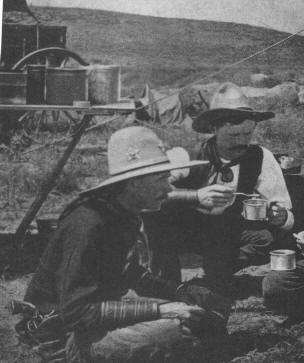
The ten gallon hat made so popular by early western movie stars like Tim McCoy, Tom Mix and others were more a device of Hollywood than reality. They were popular among movie stars and rodeo cowboys but were not utilized by the 19th century working cowboy.
Cowboy Shirts

Most work shirts between 1870 and the 1890s were of the pull over style and had buttons or lacing running partly down the front of the shirt.
The lighter weight cotton shirts were usually white or off white in color or had some type of pin striping. Earlier versions of this shirt (pre 1910) almost always had no permanently attached collar. A gentleman could attach a linen or celluloid collar if the need arose.
Pin striping is a funny thing. Some are printed and some are woven. Woe be to the cowboy who wears a printed pin stripe. A good representation of 1800s fabric is woven through and through.
Take a look a some articles of clothing made from ticking and you will see that some of them are made of fabric that looks like it came out of an inkjet printer. A good period 1800s type fabric has a heavy hand to it and is woven–not printed.
One of the cowboys favorite pass times after finishing a drive was to re-outfit and have a picture taken at a local studio. In most cases you will see that the spit shined cowpokes are wearing a basic white shirt along with their other new duds. Any money earned as wages for the trail drive was more likely to go into a new saddle, six gun, or recreation of some nature than into an expensive shirt.
If you are working toward an accurate portrayal of an 1800s cowboy, or pioneer for that matter, you can not go wrong with a basic, un-bleached, Osnaberg work shirt.
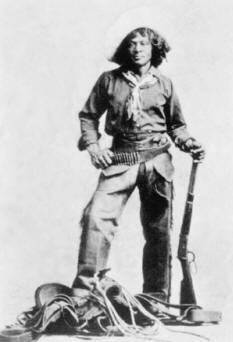
Most shirts from the 1800s had one or no breast pockets. When a cowboy reached for his tally book and pencil he aimed for a vest pocket. For that matter 1800s pants had no pockets either so vests were nothing but a big pocket for everything under the sun. (vests will be the subject of a future article).
Not all cowboy activity happened in the warm climes of the southwest. The Colorado, Wyoming, Montana and Dakota cowboys had some pretty fierce winters they had to face in the course of their duties. A wool shirt proved to be worth its weight in gold when those winter winds started to blow. Wool shirts usually ran into darker colors and, contrary to their cotton counterparts, had a roll over collar. When looking for period representation wool shirts try to stick to fabrics that have a loose weave. There is nothing that looks better and is more accurate than a good homespun fabric shirt.
“There was not really any differentiation between a work shirt and a dress shirt in the 1800s other than the fact that the dress shirt was somewhat clean.”
Following is a very detailed account from the book “The Story of the Cowboy” by Emerson Hough, published in 1897. It is probably one of the most accurate descriptions of the gear used by old west cowboys.
The Cowboy’s Outfit
In the cowboy country the fashions of apparel do not change. The fashion plates of our own history show the extremes of customs based largely upon folly or caprice, or the plots of tradespeople. The cowboy has been above such change. He is clad to-day as he was when he first appeared upon the plains. His character has been strong enough to be above prettinesses and uselessnesses. His weapons and his dress show none of the idle ornamentation bestowed by those peoples who would rather carve and embroider than march and fight.
The costume of the cowboy is permanent because it is harmonious with its surroundings. It is correct because it is appropriate. It will remain as it is so long as the cowboy himself remains what he has been and still is—a strong character, a self-poised individual, leaning on no other soul. We call his costume picturesque, but that is because it takes us into places to which we are unaccustomed.
We call the absurdities of many European natives also picturesque, with their starched and frilled appendages, which can be of no possible use or advantage in any human garb. But when we come to note closely the costume of the cowboy, we shall find that it has been planned upon lines of such stern utility as to leave us no possible thing which we may call dispensable. By the costume we may tell the man. We can not fail to recognize a nature vigorous far beyond those weak degenerates who study constantly upon changes in their own bedeckings.
The coat, trousers, and waistcoat of the cowboy are of the rough sort commonly obtained at the rude stores of the frontier. They are, of course, ready made, and of course they do not fit in the city acceptance of the term. They are sure to be of wool, and they are sure to be large and roomy enough. It is one of the odd things of the Southern country that the men largely affect black or dark-colored clothing.
The men of the Southern cities to-day nearly all wear black clothing as their business dress, and it is rarely that one sees anything but a black hat, though that would seem to be precisely the sort of wear most illy adapted to a land of blazing sun. The early cowboy ideas of perfect dress reverted somewhat to this predilection for dark clothing. In more recent times the mixed goods and lighter colors, which one would naturally consider far more sensible for such wear, have come into wider use, but this is mainly because the storekeepers of the frontier have had such goods for sale.
The typical cowboy costume can hardly be said to contain a coat and waistcoat. The heavy woolen shirt, loose and open at the neck, is the common wear at all seasons of the year excepting winter, and one has often seen cowboys in the winter time engaged in work about the yard or corral of the ranch wearing no cover for the upper part of the body excepting one or more of these heavy shirts.
If the cowboy wears a coat, he will wear it open and loose as much as possible. If he wears a vest, you will see him wear it slouchily, hanging open or partly unbuttoned most of the time.
There is reason in this slouchy Western habit. The cowboy will tell you that your vest closely buttoned about the body will cause you to perspire, so that you will quickly chill upon ceasing your exercise. His own waistcoat, loose and open, admits the air freely, so that the perspiration evaporates as rapidly as it forms. If the wind be blowing keenly when he dismounts to sit down upon the ground for dinner, he buttons up his waistcoat and is warm. If it be very cold, he buttons also his coat.
Meantime you, who have followed the customs of the ” States ” in your wearing apparel, will be needing two overcoats to keep you warm. A tight coat, a “boiled shirt,” or a buttoned waistcoat are things not recognized in cowboy land.
When we come to the boots of the cowboy we shall find apparent foundation for the charge of inutility. Very curious boots indeed they are, and it is an easy wager that one would be unable to buy a pair of them in the length and breadth of most large Eastern cities to-day.
Of fine leather, with light, narrow soles, extremely small and high heels, and fitting so tightly as to bind the foot and cramp the toes in a most vicelike grasp, surely a more irrational foot covering never was invented. Yet the cowboy wears this sort of boot, and has worn it for a generation. His ideas of ” style ” oblige him to cling to these peculiar boots, and to be particular in the make of these as well as in the fabric of his hats and gloves.
For the quality of his clothing he cares nothing whatever. Yet these tight, peaked, wretched cowboy boots have a great significance of their own, and may indeed be called insignia of a calling. There is no prouder soul on earth than the cowboy. He is proud that he is a horseman, and he has a contempt for all human beings who walk. He would prefer death to the following of a plough.
A day’s walk through the streets of the city which he infrequently visits leaves him worn out by evening, and longing for the saddle. It is a saying that he would rather walk half a mile to get a horse in order to cover a distance of a quarter of a mile than he would to walk the latter distance in the first place. The cowboy does not walk, and he is proud of the fact.
On foot in his stumpy, tight-toed boots he is lost. But he wishes you to understand that he never is on foot. And if you ride beside him and watch his seat in the big cow saddle you will find that his high and narrow heels prevent the slipping forward of the foot in the stirrup, into which he jams his feet nearly full length. If there is a fall, the cowboy’s foot never hangs in the stirrup.
So he finds his little boots not so unserviceable, and retains them as a matter of pride. Boots made for the cowboy trade sometimes have fancy tops of bright-colored leather. The Lone Star of Texas is not infrequent in their ornamentation.
The curious pride of the horseman nearly always extends also to his gloves. The cowboy is very careful in the selection of his gloves. The Ishmaelite clothier who sells him shoddy stuffs at outrageous prices in his clothing knows better than to offer the range rider sheepskin in his gloves. You will be unable also to find these gloves in the Eastern cities.
The proper glove will be made of the finest buckskin, which will not be injured by wetting. It will probably be tanned white and cut with a deep cuff or gauntlet, from which will hang a little fringe. The fluttering of little bits and things in the wind when at full speed of horseback was always one of the curious Western notions which were slow of change.
The hat of the cowboy is one of the typical and striking features of his costume, and one upon which he always bestows the greatest of care. The tenderfoot is known upon the range by his hat. He thinks it correct to wear a wide white hat, and so buys one for a couple of dollars. He is pained and grieved to find that at the ranch he is derided for wearing a ” wool hat,” and he is still more discontented with his head covering when he finds that the first heavy rain has caused it to lop down and lose all its shape.
The cowboy riding by his side wears a heavy white felt hat with a heavy leather band buckled about it, which perhaps he bought five years before at a cost of fifteen or twenty dollars; but he refers with pride to the fact that it is a ” genuwine Stetson, an’ a shore good un.” There has been no head covering devised so suitable as this for the uses of the plains.
The heavy boardlike felt is practically indestructible. The brim flaps a little, and in time comes to be turned up, and possibly held fast to the crown by means of a thong. The cowpuncher may stiffen the brim by passing a thong through a series of holes pierced through the outer edge. The heavy texture of this felt repels the blazing rays of the sun better than any helmet.
There are no recorded cases of sunstroke on the range. The record might be different were straw hats or ” derbys ” substituted for the rational headgear which for so long has been the accepted thing in the cowboy country.
The cowboy can depend upon his hat at all seasons. In the rain it is an umbrella. In the sun it is a shade and a safeguard. At night, if he sleeps cold, he can place it beneath his hips, and in the winter he can tie it down about his ears with his handkerchief, thus escaping the frostbite which sometimes assails tenderfeet who rely upon the best of caps with ear-flaps.
A derby hat is classed contemptuously under the general term ” hard hat.” Once upon a time a ranch foreman went to Kansas to get married, and report came back from the town that he had been seen wearing a ” hard hat.” It required many and elaborate explanations on his part to restore confidence in him after his return to the ranch.
There are many stories which recount the wild delight with which the cowboys greeted the appearance of a silk hat in a frontier town where they and the owner of such hat happened to be so- N joining together, and it is literally true that in the earlier days of the frontier such hats were often shot ” full of holes ” by cowpunchers who did not wait for the removal of the hat from the owner’s head.
These stories date to the wilder days of the cattle towns, when one of the favorite amusements of the wild range men was to induce some tenderfoot to dance for them by means of the persuasive argument of shooting into the ground close to his feet. Such times passed away long ago. To-day there are many gray-headed cowboys on the range who solemnly deny that they ever did exist.
A starched collar was never seen on the cow range, and it is matter of doubt what might occur to it were it attempted by one of the cowboys of a ranch. The wearer would probably soon find himself the possessor of some nickname which would cling to him for the rest of his life with annoying adhesiveness. The neckwear of the cowboy is to-day what it was decades ago.
The loose shirt collar has loosely thrown about it a silk kerchief, which may rest about the neck quite above the shirt collar. The kerchief is tied in a hard knot in front, and can hardly be said to be devoted to the uses of a neck scarf, yet it will be found a great comfort to the back of one’s neck when riding in a hot wind.
The cowboy very probably wears the kerchief in his peculiar fashion out of deference to the conventional style of the range. It is sure to be of some bright color, usually red, for these strong and barbarous natures have learned no admiration for the degenerate colors, such as pale green and the like.
A peculiar and distinctive feature of the cowboy’s costume is his ” chaps ” (chaparejos). Here the inexperienced man might think he had found ground to twit the cowpuncher with affectation, for the heavy, wide-legged and deeply fringed leg covers certainly do have rather a wild look.
The ” chaps ” are simply two very wide and full-length trouser-legs made of heavy calfskin, and connected by a narrow belt or strap. They are cut away entirely at front and back, so that *they cover only the thigh and lower legs, and do not heat the body as a full leather garment would. They are loose, roomy, and airy, and not in the least binding or confining to the limb, for the cowboy wears no tight thing about him except his boots.
The usefulness of the ” chaps ” can be very quickly and thoroughly learned by any one who rides with a cowboy for a single day over the ordinary country of the range. They are not intended for warmth at all, but simply as a protection against branches, thorns, briers, and the like, being as serviceable among the willow switches and sage brush of the North as against the mesquite and cactus chaparral of the South.
The invention, of course, came from the old Spaniards, who gave us all the essential ideas of the cattle trade. In the country where chaparejos were first worn the cactus, the Spanish bayonet, and all the steellike hooks and whips of the chaparral make a continual menace to the horseman.
The hunter in following the hounds in that Southwestern country has perhaps at times found himself in the middle of a dense growth of cacti which reached higher than his head as he sat in the saddle. To turn in any direction seemed impossible, and every movement of the horse brought fresh thorns against the unprotected legs of the rider.
Well for him then had his legs been incased in the ” chaps” he should have worn. Not even the best tanned calfskin always serves to turn the thorns and daggers of the cactus. Sometimes there is seen, more often upon the southern range, a cowboy wearing ” chaps ” made of skins tanned with the hair on. These appendages, with their long shaggy covering of black or white hair, would again tempt the inexperienced to twit the cowboy with affectation, but once more he would be wrong. The cowboy of the Southwest long ago learned that goatskin left with the hair on would turn the cactus thorns better than any other material.
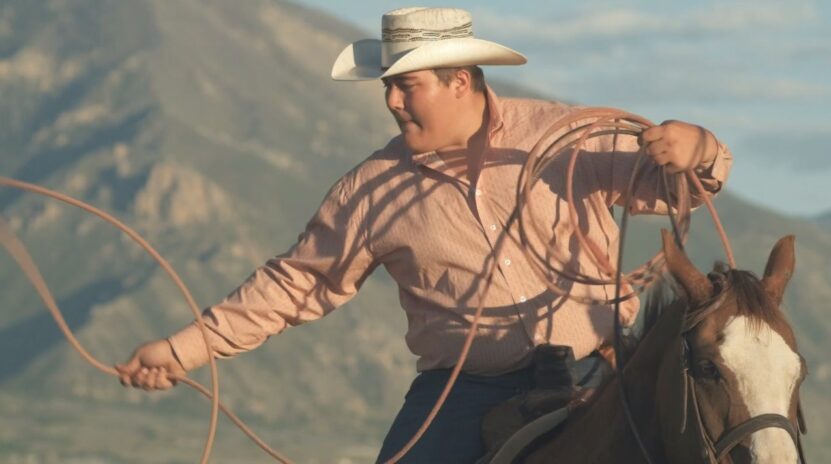
The overcoat of the cowboy, or rather his overcoat and mackintosh combined, is the ever-present ” slicker ” which he is most pleased to wear tied behind him at the thongs of his saddle. This garment is an oilskin, similar to that used by fishermen on the seacoast. It is cheap, almost indestructible, and exactly suited to its uses.
At times in the winter time, and in a colder country, the cowboy slips on a blanket coat, a long garment of heavy brown canvas lined with flannel. These coats, in a better grade, however, than is usually found upon the cow range, are issued by the Government to the soldiers at the Northern army posts, and the teamsters there declare they are as warm as a buffalo overcoat.
Of course, upon the range in a cold Northern country, where the thermometer at times reaches 45° below zero, the cowboy abandons distinctive type in clothing and dresses, as do all men in that climate, in the warmest clothing at hand. He will wear mittens then instead of gloves, and will have heavy overshoes upon his feet. Perhaps he will take to the heavy knit German socks or to the felt boots of the North. In such costume, however, we do not find the cowpuncher at his usual work, and so may dismiss it as not pertaining to his dress properly speaking.
The wearing of arms upon the person is in many of the Western territories now prohibited by law, and it is no longer customary to see the cowpuncher wearing the revolver or even carrying the Winchester which at a time not many years ago were part of his regular outfit. In some of the ruder parts of the range, and at some seasons of the dangerous cattle wars, it was a matter of personal safety that required such arms and a ready familiarity with them.
For instance, the laws of New Mexico required the citizen to ” lay aside his arms upon reaching the settlements,” and said nothing against the wearing of arms in the country outside the towns. The law was made for the safety of organized society, for the arms bearers rarely came to town except upon times of hilarity and drunkenness, and more than ninety per cent of the ” killings ” of the West occurred among men where intoxicants had been in use or were near at hand.
Thus the notorious Joel Fowler, who was eventually hung in Socorro, New Mexico, in 1883, had been required by the sheriff to ” give up his gun ” as soon as he came in town, his character when under the influence of liquor being well known. Fowler unbuckled his belt and gave the sheriff his revolver, but kept a knife concealed about him. Less than two hours later, when crazy drunk, he stabbed and killed his own ranch foreman and best friend, who had tried to persuade and quiet him.
The young sentiment then just growing in favor of law and order allowed Fowler his trial for this, but his lawyers took appeal and got the final hanging postponed for too long a time; so the citizens, who had only waited for the hanging as matter of form, concluded to save expense and keep on the safe side by hanging Joel themselves, which they did, leaving him, in spite of his loud objections thereto, suspended to a telegraph pole.
That was back in what might be called the old times on the range, yet even then the sentiment against bearing arms was beginning to be felt, and some ranch owners would not allow their men to carry the revolver at all. Later on, say in 1887, on some of the ranges not so wild as the far Southwestern country, there was slowly growing a sentiment against the wearing of a ” gun.”
In 1894, in one of the wildest parts of Texas, one heard a ranch foreman say, with a noticeable personal pride, that he ” never did pack a gun.” The candor of this statement is open to a shadow of doubt, for that same foreman had spent his life upon the cow range, and in the old times the cowpuncher certainly did ” pack a gun.” Indeed, he looked upon it as a part of his dress and one of the necessities of life, and as such it should be mentioned here.
The cowboy never wore ” galluses ” (braces), and he rarely wore a belt to support his trousers, depending upon buttoning them tightly enough for that purpose; but he did wear a belt, this the wide, heavy leather belt that carried his pistol holster. This belt had loops for half a hundred cartridges, and the total weight of the affair, gun and all, was several pounds.
No pistol of less than .44 caliber was tolerated on the range, the solid framed .45 being the one almost universally used. The length of the barrel of this arm was eight inches, and it shot a rifle cartridge of forty grains of powder and a blunt-ended bullet that made a terrible missile. In the shooting affairs of the West some one nearly always got killed, because the weapons used were really deadly ones. The tenderfoot who brought the little .32 pistol of the ” States ” to the range was laughed at till he threw it away.
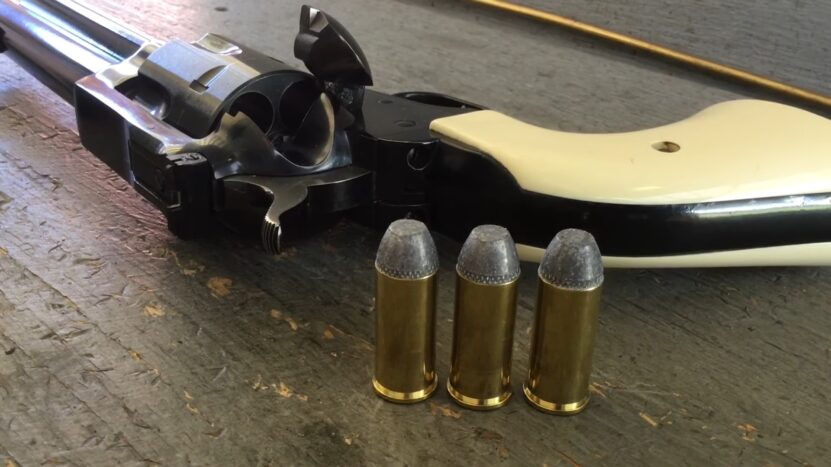
Thereupon the tenderfoot bought a .45, and was very wretched. He found the heavy thing almost unsupportable in its constant dragging down, and he could never get at it when he wished to practice on a prairie dog. He buckled the belt tightly about his waist, and perhaps decorated himself with one of the useless sharp-pointed knives which, for some inscrutable reason, have always had a place and a sale in the Eastern sporting-goods shops under the name of ” hunting knives,” though they are scorned by any man who really hunts or who has ever lived in the West.
If our tenderfoot would study the belt of the cowpuncher he might learn something to his benefit. He would, of course, see no knife there. The foreman has a clasp knife at the branding corral for purposes connected with his work, but the cowboy has none at his belt. The belt itself is not buckled about his waist at all, but is worn loose, resting upon the point of the hip on the left side, and hanging low down upon the hip on the right side, none of the weight of the gun coming upon the soft parts of the abdomen at all.
In riding, a cowpuncher’s gun is no encumbrance to him, and he gives it no more thought than a well-dressed man does his necktie. Yet quicker than the latter citizen could jerk loose his tie the cowpuncher can jerk loose his gun. Knowing the value of time and the danger of overshooting in a little affair, he will begin to ” set the gun agoing ” as soon as it gets out of the holster, maybe cutting a little dust inside the distance of his man, but before the second or so of the time of the shooting is past something has usually happened.
Some of the bad men of the West tied back or removed altogether the triggers of their revolvers, thus simplifying the lock and making it more absolutely certain. The gun can be fired much more quickly by cocking and releasing the hammer with the thumb, all six of the shots being thus almost continuous in the hands of a trained gun fighter.
The two horse thieves who were killed in lower Kansas by Three-finger Carter, after their long flight across the range from Nebraska in the early ’80’s, had their revolvers thus arranged. Though Carter was lucky enough to get in two shots with a Sharps rifle, which killed one and disabled the other before they had managed to hit him, he said that the ” ar was plum full o’ lead ” while he was getting in his second cartridge.
The well-founded respect which the cowpuncher had for simplicity and certainty in his arms caused him to generally reject the double-action revolver. His dependence was placed in the old-style single-action revolver, with the wooden handle. Some young and more modern cowboys sometimes ” toted” guns with pearl or ivory handles, on which the head of a ” longhorn ” was sometimes engraved handsomely; but these works of art were not cherished in the holsters of the old-time men.
The genuine cowboy of the times when some men needed guns and all men carried them, wanted a gun that would ” shore go off” when it was wanted. It needed to be an arm which would stand rain and sun and sand, which could be dropped in a stampede and run over by a herd of cattle, but which when picked up would still be ready to go to shooting.
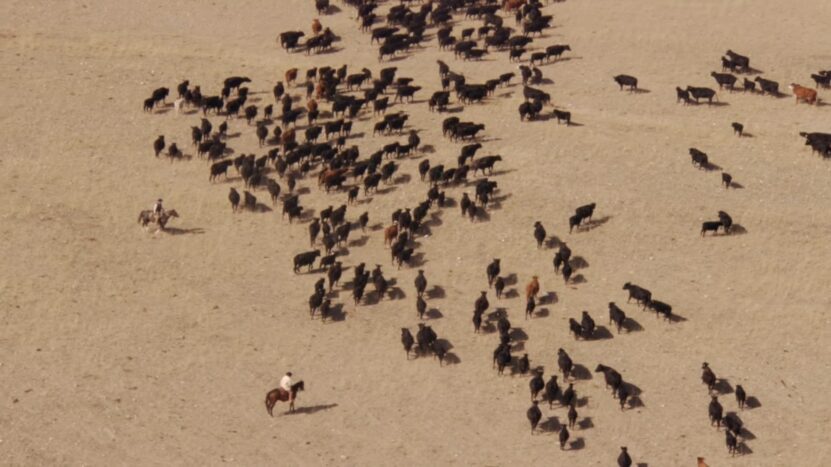
The cowpuncher wore his revolver on the right hip (if a right-handed man), and the butt of it pointed backward. The army man wears his revolver on the left side, with the butt pointing forward—about as poor a way as could be devised, though of course the saber is supposed to occupy the right hand of the cavalryman and most of his personal attention.
The cavalryman who goes on many plains marches soon learns of the plainsman how to carry his belt without fatiguing himself to death with his own weapons.
An essential part of the cowpuncher’s outfit is his ” rope.” This is carried in a coil at the left side of the saddle-horn, fastened by one of the many thongs which are scattered over the saddle.
The rope in the Spanish country is called reata {la reata), and even to-day is often made of rawhide, with an eye re-enforced with that durable material. Such a hide rope is called a ” lariat” in the South. The reata was softened and made pliable by dragging it for some days behind the ranch wagon or at the saddle, the trailing on the ground performing this function perfectly.
The modern rope is merely a well-made three-quarter-inch hemp rope, about thirty feet in length, with a leather eye admitting a free play of the noose, the eye being sometimes well soaped to make the rope run freely. This implement is universally called on the range a ” rope.” The term ” lasso,” which we read about in books, is never heard, unless in California, nor is the common term of the Mexican, ” reata.”
The ” lariat” is in the North used sometimes as another term, more especially to describe the picket rope by which the horse is tied out. In Texas this would be called a “stake rope.” The common name gives the verb form, and the cowpuncher never speaks of ” lassoing ” an animal, but of ” roping ” it.
The ” quirt” of the cowpuncher (possibly from the Spanish cuerda, a cord or thong) is a short and heavy whip, made with a short stock less than a foot in length, and carrying a lash made of three or four heavy and loose thongs. The handle is a wooden stick, or sometimes a short iron rod, covered with braided leather, and a thong attaches the quirt to the wrist.
The quirt is now made as a regular article of saddlery, but in the early days the cowboys often made their own quirts. The cowpuncher took to leather and rawhide as a fish to water, and some of them, especially those from the Spanish Southwest, were exceedingly clever leather workers. But they never cared much for the fancy-colored quirts so ingeniously braided of horsehair by the Mexicans, who are fonder of display than the American cowpuncher proper.
The quirt was merely supplement to the spur which the cowpuncher wore on each foot. The spur in the old days was made with a very large rowel, the latter being a great wheel, with blunt teeth an inch long about its circumference. Often little bells or oblong pieces of metal ornamented this spur, the tinkling of which appealed to the childlike nature of the plains rider of the early days. The style of spur has come down without pronounced change.
The bridle used by the cowboy—for we may as well continue to speak also of the dress of the cowboy’s horse—was noticeable for its tremendously heavy and cruel curbed bit. This bit was originated by the most cruel people in the world, the Spaniards, and it has in some form retained its hold in the most cruel occupation of the world, the cattle business of the plains.
A long shank hung down from the bit on either side of the mouth, and low down on these shanks were fastened the reins, with a leverage sufficient fairly to tear the jaw off a pony. Inside the mouth there was a cross bar of iron, made with a IT bend in the middle. The pull on the reins could sink this U deep into the horse’s tongue, sometimes nearly cutting it off. Very severe was the “spade bit,” which could be forced into a horse’s mouth willy-nilly, and still more cruel was the ” ring bit,” with its circle slipped over the lower jaw of the horse.
This savage Spanish bit went out of common use as the Anglo-Saxon cattle men came in. It was capable of breaking the jaw of a horse, and has been known to do so. More humane bits are used now than in the past, and probably horses are upon the average not so ” broncho ” as the original Spanish ponies. In the wild riding of the cowboy he sometimes mercilessly jerks the pony up with his terrible bit, so sharply as to throw it back upon its haunches.
The horsemanship of the plains has absolutely no reference to the feelings of the horse. It is the part of the latter to obey, and that at once. Yet in the ordinary riding, and even in the arduous work of the round-up and in cutting out, the cowpuncher uses the bit very little, nor exerts any pressure on the reins.
He lays the reins against the neck of the pony on the side opposite to the direction in which he wishes it to go, merely turning his hand in the direction, and inclining his body in the same way. He rides with the pressure of the knee and the inclination of the body, and the light side shifting of both reins equally tightened. A cow pony does not know what you want of it if you pull upon the rein on one side. They have been known to resent such liberties very promptly.
The saddle of the cowboy is the first, last, and most important part of his outfit. It is a curious thing, this saddle developed by the cattle trade, and the world has no other like it. It is not the production of fad or fancy, but of necessity. Its great weight— a regular cow saddle weighs from thirty to forty pounds—is readily excusable when one remembers that it is not only seat but workbench for the cowman.
A light saddle would be torn to pieces at the first rush of a maddened steer, but the sturdy frame of a cow saddle will throw the heaviest bull on the range. The saddle is made for riding upon a country essentially flat, and it is not intended for jumping—indeed, can not be used for high jumping, with its high cantle and pommel. Yet it is exactly right for the use for which it is designed. The high cantle gives a firmness to the seat of the cowboy when he snubs a steer with a sternness sufficient to send it rolling heels over head.
The high pommel, or ” horn,” steel forged and covered with cross braids of honest leather, serves as anchor post for this same steer, a turn of the rope about it accomplishing that purpose at once. The tree of the saddle forks low down over the back of the pony, so that the saddle sits firmly and can not readily be pulled off.
The great broad cinches—especially the hind cinch so much detested by the pony, and a frequent incentive to steady bucking—bind the big saddle fast to the pony until they are practically one fabric. The long and heavy wooden stirrups seem ungraceful till one has ridden in them, and then he would use no other sort.
The strong wooden house of the stirrup protects the foot from being crushed when riding through timber or among cattle or other horses. The pony can not bite the foot—as he sometimes has a fashion of doing viciously—through the wood and the long cover or leather that sometimes further protects it, neither can the thorns scratch the foot or the limbs of trees drag the foot from its place.
The shape of the tree of the cow saddle is the best that can be made for its use, though it or any other tree is hard upon the pony’s back, for the saddle is heavy of itself, and the rider is no mere stripling.
The deep seat is a good chair for a man who is in it nearly all the year. In the saddle the cowpuncher stands nearly upright, his legs in a line from his shoulders and hips down. He rides partly with the balancing seat, and does not grip with his knees so much as one must in sitting a pad saddle, but his saddle is suited to his calling, and it is a bad horse and a big steer that shall shake him, no matter what the theories of it be.
The question of the cowpuncher’s saddle and his use of it can be covered with a little conversation once heard on the trail of a cow outfit. A gentleman of foreign birth, but of observing habits, was telling a cowpuncher what he thought about his riding and his saddle. ” I say, you couldn’t jump a fence in that thing, you know,” said he.
” Stranger,” said the cowpuncher, ” this yer is God’s country, an’ they ain’t no fences, but I shore think I could jump more fences than you could rope steers if you rid in that postage stamp thing of yourn.”
The cowboy loves his own style of saddle, but he goes further than that. He is particular to a nicety in selecting his saddle, and, having once selected and approved of it, he can not be induced to part with it or exchange it for any other. He might sell his gun or his coat or his boots, and he cares nothing how many times he changes his horse, for which he has no affection whatever, but he will never part with his saddle.
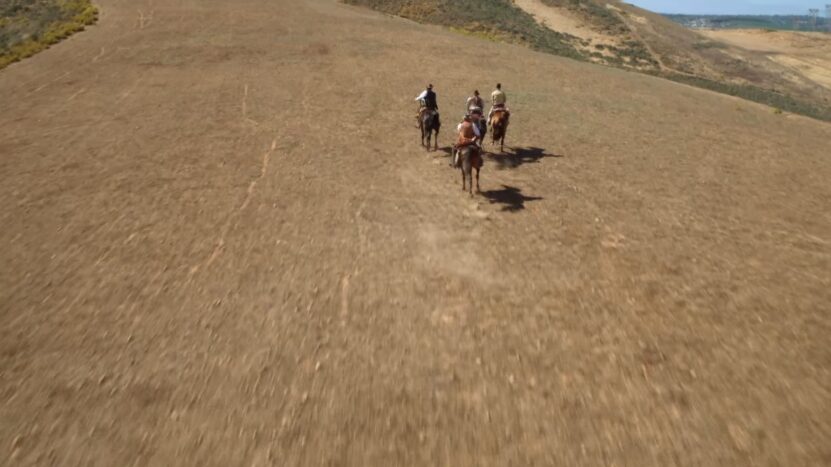
The cowboys who came up with the drive from the lower range in the early days took their saddles back home with them, no matter how long the journey. To sell one’s saddle was a mark of poverty and degradation, and perhaps the cowpuncher felt about it much as the Spartan mother about the loss of her son’s shield. No matter how dark it is when he saddles up, no cowpuncher ever gets any saddle but his own, and should any one borrow or misplace his there is apt to be explanation demanded.
In the early days of the ” Texas saddle,” or the first type of the cow saddles, these articles were made in the shops of the Southwest. Before long, however, after the drive got into the Northern country, the saddles of Cheyenne became the favorites of the range, North and South, they being made of better leather. The ” California tree ” was sometimes used.
There was some local variety in manufacture, but the saddle of the cowman remained constant in the main points above mentioned. The old Spaniard who designed it put forth many models which have endured practically without change.
A good saddle would cost the cowboy from forty to one hundred dollars. In his boyish notions of economy to want a thing was to have it if he had the money, and a saddle once seen and coveted was apt to be bought. The embossing and ornamentation of the saddle had most to do with its cost. The Spanish saddles of the Southwest were often heavily decorated with silver, as were the bits, spurs, and bridle reins, as well as the clothing of the rider; but this sort of foppery never prevailed to any extent among American cow punchers.
There was one rude and wild sort of decoration sometimes in practice by the younger cowboys on the range. They often took the skins of rattlesnakes, of which there were very many seen nearly every day, and spread them while yet wet upon the leather of their saddles. The natural glue of the skin would hold it firmly in place when it dried. Some saddles have been seen fairly covered with these lines of diamond-marked skins. It was not uncommon to see the skins of these snakes also used as hat bands.
Let us suppose that chance has brought us to some one of the little frontier towns in or near the edge of the cattle country, and that there is in the neighborhood of the village a band of cattle in the care of the usual outfit of cowboys. Perhaps the duties of these are well over for the time, they having shipped their cattle or turned them over to another owner. It is in the evening, and the party of cowboys have concluded to come to town for a little celebration.
Far across the open prairie country we may see them coming, their way marked by the rapidly flitting cloud of white dust. In a few moments they are near enough for one to make out their figures. They sit straight up in the saddle, their legs straight down, the body motionless except through the action of the horse. They are in their shirt sleeves, their hats blowing back, their right hands occasionally wielding the quirts as they race headlong over the rough ground of the unbroken prairies.
Now and again their heels strike home the spurs to push on the racing ponies, which come flying, their heads low down, their legs gathered well under them, their ears back, their nostrils wide. As the wild range men come on one hears their shrill call, the imitation of the coyote yelp.
They dash into the main street of the town, never drawing rein, but spurring and whipping the harder, the hoofs of the horses making a louder beat upon the hard streets. On they ride, yelling and spurring, their loose scarves flying, but each man upright and steady as a statue in his seat. They arrive at the main portion of the town, perhaps at the central ” square,” about which some of these towns are built. Still at full speed, each man suddenly pulls up his horse with a strong jerk upward of his hand.
The heavy bit does its work. The pony, with its head tossed high by the sudden pull, which it has learned instantly to obey, throws its weight back as it does in the corral when the rope has flown. It falls back upon its hind legs, sliding upon its fetlocks, and coming to a stop from full speed within a few feet. Before it has fully paused the rider is off and has thrown the reins down over its head. Then, while the pony rolls its eye in resentment, you will have opportunity to see the cowboy on his feet and dressed in his working clothes.2
- The Passing of the Frontier – Emerson Hough – 1918
- The Story of the Cowboy – Emerson Hough – 1897
